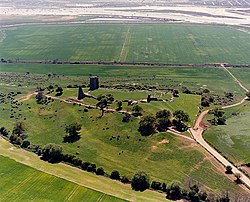Hadleigh Castle
| Hadleigh Castle | |
|---|---|
| Essex, England | |

Aerial view of Hadleigh Castle from the north, with the Thames Estuary in the background
|
|
| Coordinates | 51°32′40″N 0°36′32″E / 51.5444°N 0.6090°E |
| Grid reference | grid reference TQ810860 |
| Site information | |
| Owner | English Heritage |
| Open to the public |
Yes |
| Condition | Ruined |
| Site history | |
| Materials | Kentish ragstone |
Hadleigh Castle is a ruined fortification in the English county of Essex, overlooking the Thames Estuary from south of the town of Hadleigh. Built after 1215 during the reign of Henry III by Hubert de Burgh, the castle was surrounded by parkland and had an important economic and defensive role. The castle was significantly expanded and remodelled by Edward III, who turned it into a grander property, designed to defend against a potential French attack, as well as to provide the King with a convenient private residence close to London. Built on a geologically unstable hill of London clay, the castle has often been subject to subsidence; this, combined with the sale of its stonework in the 16th century, has led to it now being ruined. The remains are now preserved by English Heritage and protected under UK law as a Grade I listed building and scheduled monument.
Hadleigh Castle was first built by Hubert de Burgh, the 1st Earl of Kent, who was a key supporter of King John. De Burgh was given the honour of Rayleigh by John in 1215 as a reward for his services, but chose not to develop the existing caput of Rayleigh Castle, instead building a new fortification south of the town of Hadleigh. The exact date of construction is uncertain, but it is now believed the work was conducted early in de Burgh's tenure of the site, permission being retrospectively officially confirmed through a licence to crenellate in 1230 under Henry III.
...
Wikipedia

